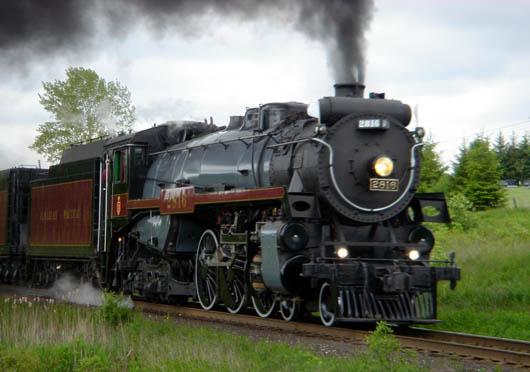
29 July 2008
Empress Still Has Her Steamy Side

Canadian Pacific Railway Hudson class H1b number 2816, The
"Empress" - Date/photographer unknown.
 Port Coquitlam British Columbia - The Empress is taking
her bath. Two men in yard uniform - Canadian Pacific overalls - spray, scrub, and mop. They begin at the tip of the locomotive's nose,
moving with precision down the long metal snout to the empty cab, finally swabbing the tender and the other rolling stock.
Port Coquitlam British Columbia - The Empress is taking
her bath. Two men in yard uniform - Canadian Pacific overalls - spray, scrub, and mop. They begin at the tip of the locomotive's nose,
moving with precision down the long metal snout to the empty cab, finally swabbing the tender and the other rolling stock.
CP 2816 Empress is more babied than a Lamborghini. Freshly greased and painted, she rolls clean as a whistle, always, as befits a
78-year-old steam locomotive, perfectly restored to a fine working condition. Fussed over by a dedicated crew of eight
from from Canadian Pacific Railway Ltd.'s wildly anachronistic (and remarkable-for-its-very-existence) Department of Steam
Operations, the iron lady is getting prepped for another eastward run, from the West Coast into the B.C. interior and the Rockies, to
Calgary and then beyond.
By summer's end it will have travelled thousands more kilometres and will have been seen by hundreds of thousands of Canadians.
CP 2816 has crossed the country hundreds of times before; it made its first trip at the start of the Great Depression, well before any
of its current crew members were born. A common H1b Hudson-type locomotive, it was built by Montreal Locomotive Works in
1930 for just under $120,000. Like dozens of other CPR Hudsons, it was reliable and fast, a workhorse that provided CPR with three
decades of passenger service, first on the Calgary-Winnipeg-Fort William (near Thunder Bay) run, then along the Quebec
City-Windsor corridor.
After logging more than three million kilometres, CP 2816 was retired in 1960. Steam travel had petered out and most passenger rail
service in Canada would soon go the way of horse and cart.
The locomotive was sold off in 1964. It sat on display in Ohio, a sad, corroding monument, like dozens of other idled locomotives
scattered about North America.
In the late 1990s, CPR experienced a spasm of corporate hubris. The company decided to go looking for an old locomotive that it could
use to celebrate its heritage, and found CP 2816. A fussy crew of assigned staff and volunteers restored it.
Its fire now burns diesel - the proper grade of coal is too hard to source - and the operators use communications equipment and other
electronics, but otherwise, it runs pretty much in the same old fashion. By 2001, CP 2816 was back on the rails, producing 3,000
horsepower, hauling butt at up to 100 kilometres an hour, turning heads.
It's now in special service from 70 to 100 days each year, and can turn up anywhere in North America. This is not some relic, or a
captive locomotive that runs mindless circles around some amusement park track, explains its master, engineer and CP steam operations
manager Bill Stetler.
It leaves soon for its home yard in Calgary, with an IMAX film crew occupying one of the old coaches and one of its cameras placed near
the locomotive's two stacks. CP 2816 pulls up to 15 pieces of restored equipment, including business, crew, and tool cars. These once
belonged to other railways and were found in "various stages of disarray, Mr. Stetler says. "We fixed 'em up, painted 'em,
put our brand on 'em."
He walks me down the length of the locomotive's boiler and then shows me into the cab, all the while pointing to details that I would
otherwise have missed: a metal service and specifications plaque, placed by Montreal Locomotive Works in October, 1937; authentic
nickel driving rods; forged tires on the wheels; the cab's wooden floor.
About 12,000 imperial gallons of water are slowly heating inside the jacketed boiler. Loud bangs are heard as water heats and steam
pressure builds and the metal tank expands. By nightfall, the end of the boiler will push three inches into the cab. Only then will the
heavy locomotive have the wherewithal to move.
Standing inside the cab, Mr. Stetler will pull on the whistle. The six tall driving wheels will be let forward and in 30 minutes the
locomotive will be flying alongside the Fraser River, a blur of fire and metal and steam power.
It's a minor miracle, built to an immense scale. The locomotive sits on its rails the way an ocean liner rests at a dock:
appearing even larger than you expected, and glamorous. Irresistible eye candy.
She is the CPR's "rock star," attracting crowds of admirers wherever she goes, say railway workers. More photographed than
some pop idols (loco-buffs have risked life and limb to film the thing as it bears down the rails toward them) it's part
promotional device, part private rail tour accessory, and part corporate morale-builder. "I think it sends a message
about excellence, that we can actually operate a steam engine on a Class 1 railway with 14,000 miles of track," Mr. Stetler says.
"That takes tenacity and ingenuity."
And money. CP 2816 was restored for an amount rumoured to be in the neighbourhood of $2-million. Mr. Stetler avoids my
inquiry. "It's not always about the dollars," he shrugs.
Some company employees and shareholders might not think it's worth the money or the effort. But they might not be like the rest of us,
people who can catch the spell of time travel, in a magnificent old machine.
|